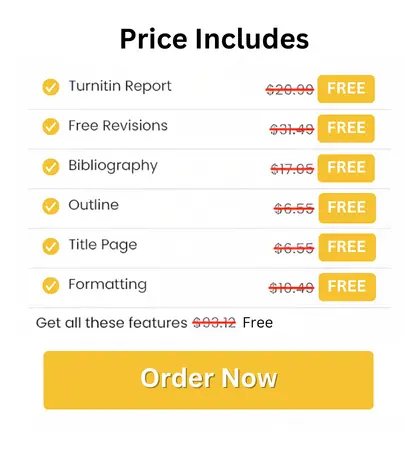
MEM603 Engineering Strategy Report 2 Sample
Task Details
Critically review in 2,000 words (+/-10%) the engineering strategy (in relation to research and development (R&D), technology, innovation and intellectual property (IP) management) of an organisation known to you. Describe and critically assess how the company has integrated this strategy internally with other parts of the organisation and externally with its partners and alliances.
Instructions
For this assessment, you will use a strategy process, methodology and tools to critically review the engineering strategy of an organisation and then critically assess how the engineering strategy has been integrated with internal and external stakeholders.
To complete this assessment, you need to research and examine the following issues in relation to the engineering strategy of an engineering or technical organisation of your choice:
1. Describe the current engineering strategy of the organisation.
• A strategy consists of an understanding of the current situation, the desired future situation and the actions that need to be undertaken to move to the desired future and achieve the vision and objectives.
• An engineering strategy generally covers a number of areas, such as R&D, technology, innovation and IP management. These areas may be addressed by one or separate strategies.
2. Critically review the existing engineering strategy.
Ideally, an engineering strategy should meet a number of criteria. Specifically, an engineering strategy should:
• Provide direction, aims and objectives and decisions about future actions in technology, innovation, R&D and IP management;
• Prescribe consistent strategic choices dealing with the deployment of resources to achieve the objectives; and
• Answer the following questions: What is to be accomplished? Why do we want to do it? How are we going to do it? What resource commitments are necessary?
3. Critically assess how the engineering strategy integrates internally and externally to the organisation. Specifically, consider:
• The overall corporate strategy. The engineering strategy needs to align with and support the overall organisational strategy;
• Other parts of the organisation, such as those responsible for operations, marketing, finance and human resources. The engineering strategy needs to identify linkages and indicate how these and others will be strengthened; and
• External stakeholders (e.g., strategic alliances with universities and research organisations) and partnerships (e.g., joint ventures or licensing agreement). The engineering strategy needs to identify partners and alliances that will help the organisation to achieve its objectives
You may wish to use the following as a guide for structuring your assessment:
1. Introduction
2. Background
3. Research description of the engineering strategy
4. Review (pros and cons) of the engineering strategy
5. Research description of how the engineering strategy integrates with other parts of the organisation and external partners and strategic alliances
6. Assess (pros and cons) of how the engineering strategy has been integrated internally and externally within the organisation
7. Conclusions
8. References
9. Appendices
Referencing
Use APA style to cite and reference your research
Solution
Introduction
This report critically reviews Toyota’s engineering strategy, focusing on its alignment with the company’s overall corporate strategy, integration with internal organizational departments, and collaboration with external stakeholders and partners. The assessment examines the current engineering strategy of Toyota, critically reviews its pros and cons, and assesses how the strategy has been integrated internally and externally within the organization. By evaluating these aspects, the report aims to provide a comprehensive understanding of the effectiveness of Toyota’s engineering strategy in driving innovation, technological advancement, and sustainable growth within the automotive industry.
Background
Engineering strategy plays a crucial role in organisations in order to meet the set goals and targets concerned to research and development (R&D), innovations, technology, and IP management. The engineering strategy provides a set of decisions and actions needed in these areas. For it to be truly effective, the engineering strategy must align with and support the overall corporate strategy, integrate with other internal functions like marketing and operations, and link externally with strategic partners, alliances, and stakeholders.
Company Background
The chosen organisation is Toyota, the company was founded in 1937, throughout the years the company has gained a promising position all across the world in the automotive manufacturers. It’s a Japanese company and Japan tends to have one of the most efficient and intelligent technological solutions. Toyota, a global vehicle manufacturer, serves as an example of the importance of efficient engineering strategy. With its commitment to innovation, research and development, and technology management, Toyota has spearheaded the industry with its focus on sustainable mobility. The company's involvement in electric vehicles (EVs), hybrid and fuel cell technology reflect its cutting-edge approach and environmental sustainability commitment (Woodward, 2024).
.png)
Figure 1: Toyota
(Source: TOYOTA MOTOR CORPORATION, 2024)
Assessment objective
The objective of this assessment is to critically review Toyota's engineering strategy related to R&D, technology, innovation and IP management. It will describe Toyota's strategy, assess its merits, and analyze how well it integrates both internally across Toyota's divisions as well as externally through strategic partnerships and alliances .
Research Description of The Engineering Strategy
The multifaceted engineering strategy of Toyota places innovation, sustainability and technology at its center. By being at the forefront of the automotive industry, Toyota has decided to become the leader in the age of electric vehicles (EVs), hybrids and fuel cell technologies, with also looking forward to the enhancement of total vehicle performance, safety, and user experience for university assignment help.
i. Research and Development (R&D)
• Sustainable Mobility: Toyota is a company dedicated to decreasing the carbon footprint of its vehicles and has some valuable achievements on this way. The hybrid technology of the company is a renowned success and it is an applaudable one for its fuel efficiency and low emissions, since it combines an internal combustion engine and an electric motor. Moreover, Toyota is closing in on battery technology and infrastructure to usher in the electric car revolution (Park et al., 2020).
• Advanced Safety Features: Safety is paramount to Toyota and the company is committed to perfecting vehicle safety by developing advanced ADAS features and autonomous driving systems. Toyota's Safety Sense kit, which boasts features such as pre-collision systems, lane departure alerts, and adaptive cruise control, illustrates the company’s stance of making roads safer for everyone, including all road users (Mainwaring, 2021).
• User Experience and Connectivity: Toyota is using technology to improve the user interface and give connectivity to people in the cars it makes. The company is designing in intelligent infotainment systems, smartphone connectivity, and AI-based voice recognition systems to enable motorists and passengers to have a pleasant and truly smart journey (Potter & Paulraj, 2021).
ii. Technology Management
• Open Innovation: Working together with start-ups, research institutions, and technology firms, Toyota constantly seeks to innovate and advance the level of technology. With the help of the Toyota AI Ventures and alliances with big tech companies like Google and Nvidia, Toyota is able to step on the external knowledge and capabilities, and therefore speed up the technology development in order to remain competitive (Morgan & Liker, 2020).
• Digital Transformation: Toyota is employing digitalization to maximize its engineering processes, perfect the product development, and boost production efficiency. The firm is aligning itself with the latest digital technology such as artificial intelligence (AI), machine learning, and big data analytics to optimize processes and thereby deliver new, top-quality, innovative products to the market (Tomlins et al., 2021).
iii. Innovation
• Patent Filing: Toyota constantly files patents to protect the innovations and make sure that the company’s intellectual property is insured.
• Licensing and Collaboration: Toyota works with its fellow automakers and technology companies for licensing and cross-sharing of technology and IP, increasing revenue and bringing industry-wide technological development (Uchida, 2024).
Pros and Cons of The Engineering Strategy
.png)
.png)
.png)
Table 1: Pros and Cons of The Engineering Strategy
Strategy Integration with Other Parts of the Organisation
Alignment with Overall Corporate Strategy
Toyota's engineering strategy is re-enforced and aligned comprehensively with the company's overall strategic ambitions, while attention is paid to the internal relationships and building strong external alliances. Ensuring that the marketing strategy is well-aligned with the overall corporate strategy involves a thorough analysis of the goals and objectives set by the organization. Toyota’s engineering strategy is fundamentally linked with the company’s overall corporate strategy, which concentrates on the sustainability, innovation, and client-centricity. The engineering strategy uses R&D, technology development, and IP management, which directly support the corporate goals, namely, the provision of high-quality and innovative products and maintaining the leadership in the automotive industry (Hanelt et al., 2021). As a result, this internal alignment guarantees that the engineering solution is not an isolated part, but it is a part of the company's overall objectives, which in turn creates a platform for collaboration and synergy across all organizational levels.
Integration with Other Parts of the Organisation
Through systematic cross-functional collaboration and setting of engineering objectives in line with broader business goals, Toyota effectively integrates manufacturing strategy with other organizational departments such as operations, marketing, finance, and human resources.
• Operations: Toyota’s engineering strategy works hand-in-hand with operations to ensure that the innovative technologies which are the output of the R&D cycle are feasible to produce at scale. This approach integrates the processes, reducing the costs and delivery time (Winardy et al., 2021).
• Marketing: Toyota’s engineering strategy involvement with the marketing function enables the marketing team to build and release appealing new technologies promptly through social media channels, digital marketing, and traditional marketing strategies. Getting engineering involved in company marketing and aligning it with customer preferences can be influential in selling cars.
• Finance: Toyota’s engineering strategy effectively aligned with the company’s financial planning and budgeting activities. The firm favors strategic allocation of funds for R&D, technological development and knowledge-based innovation and therefore uses available resources to maximize profits and ensure long-term growth (Rahman & Acharya, 2020).
• Human Resources: Within this culture, Toyota encourages innovation and improvement that never stops. Regardless of industry, or business, the engineering strategy has to be synchronized with HR policies and practices to make staff development, training and the recruitment of skilled and experienced people possible, pointing that the organization has the required skills and expertise to facilitate innovation and remain competitive (Hanelt et al., 2021).
Integration with External Stakeholders and Partnerships
Toyota’s engineering strategy involves collaboration with the external entities; strategic alliances, research organizations, universities, and partnerships, identified as the key drivers of innovation and enhancing of technological advancement.
• Strategic Alliances with Universities and Research Organizations: Through having international relationship with academic institutions and research centers worldwide, Toyota continues to seek for enhanced technologies with purpose of automobiles. Such partnerships help Toyota to tap outside resources, abilities, and science leading edge to promote quick through of innovations and create the barrier for competitors.
• Joint Ventures and Licensing Agreements: Toyota has been at the forefront of the automotive industry through joint agreements and license contracts with automotive peers as well as tech companies to avail advances in technology, facilitate the industry-wide ongoing technology advancements and creating further revenues (Isensee et al., 2023).
Pros and Cons of Integration
.png)
.png)
Table 2: Pros and Cons of Integration
In summary, while Toyota has made significant strides in integrating its engineering strategy both internally and externally through well-structured initiatives and partnerships, some areas like regional alignment and cultural barriers present ongoing challenges to fully optimized integration.
Conclusion
Toyota employs strong and coordinated engineering strategy that is in line with its overall corporate strategy, reinforces inter-divisional cohesiveness from operation to marketing and finance to HR, and enables strong collaborations with universities and research teams as well as other technology companies Although the strategy gives a clear direction, investment of the resources, and effectiveness in collaboration, there are still areas to work on among which the most important are scalability of innovation, strengthening IP enforcement mechanisms, and ratification of digitalization and emerging technologies. Solving these problems will allow Toyota to keep a strong position on the automotive market and will lead the company to the sustainable growth in the long term.
References
GlobalData. (2023, July 5). Toyota Motor Corporation - Digital Transformation Strategies. Market Research Reports & Consulting | GlobalData UK Ltd. https://www.globaldata.com/store/report/toyota-motor-corporation-enterprise-tech-analysis/#:~:text=Toyota%20Technology%20Theme%20Focus,operational%20efficiency%20and%20product%20offerings.
Hanelt, A., Bohnsack, R., Marz, D., & Antunes Marante, C. (2021). A systematic review of the literature on digital transformation: Insights and implications for strategy and organizational change. Journal of management studies, 58(5), 1159-1197. https://onlinelibrary.wiley.com/doi/pdf/10.1111/joms.12639
Isensee, C., Teuteberg, F., & Griese, K. M. (2023). Success factors of organizational resilience: a qualitative investigation of four types of sustainable digital entrepreneurs. Management Decision, 61(5), 1244-1273. https://www.emerald.com/insight/content/doi/10.1108/MD-03-2022-0326/full/html
Mainwaring, S. (2021, December 10). Purpose At Work: How Toyota Is Driving Growth, Innovation And Impact. Forbes. https://www.forbes.com/sites/simonmainwaring/2018/11/13/purpose-in-action-how-toyota-is-driving-growth-innovation-and-impact/
Morgan, J., & Liker, J. K. (2020). The Toyota product development system: integrating people, process, and technology. Productivity press. https://www.ame.org/sites/default/files/target_articles/06-22-4-BR_Toyota_Prod_Dev_Sys.pdf
Ondeng, T., & Nekesa, T. (2022, September 19). Case Study Critical Analysis for Toyota Motor Corporate Strategy. ResearchGate; unknown. https://www.researchgate.net/publication/363659699_Case_Study_Critical_Analysis_for_Toyota_Motor_
Corporate_Strategy
Park, Y., Nakaoka, I., & Chen, Y. (2020). The R&D Strategy of Automobile Companies in Radical Innovation. J. Robotics Netw. Artif. Life, 7(3), 184-189. https://alife-robotics.org/article/vol7issue3/125944530.pdf
Potter, A., & Paulraj, A. (2021). Unravelling supplier-laboratory knowledge spillovers: Evidence from Toyota's central R&D laboratory and subsidiary R&D centers. Research Policy, 50(4), 104200. https://www.sciencedirect.com/science/article/abs/pii/S0048733321000044
Rahman, A., & Acharya, P. (2020). A Comparative Study on Financial Performance of Tata Motors and Toyota Motor Corporation Cars. Available at SSRN 4173857. https://www.researchgate.net/profile/Manju-
Govindharajan/publication/367362342_A_Study_on_Investment_Prefrence_Towards_Working_Women_Investors
_with_Special_Reference_to_Erode_District_of_Tamilnadu/links/63cfbc7e6fe15d6a574331a8/A-Study-on-Investment-Prefrence-Towards-Working-Women-Investors-with-Special-Reference-to-Erode-District-of-Tamilnadu.pdf#page=76
Sobek, D. (2022, July). Another Look at How Toyota Integrates Product Development. Harvard Business Review. https://hbr.org/1998/07/another-look-at-how-toyota-integrates-product-development
Tomlins, R., Malynka, O., Sukumar, A., Rao, M., & Pandya, K. (2021). Radical innovation process in sustainable development and knowledge management: Toyota Prius case study. In IOP Conference Series: Earth and Environmental Science (Vol. 628, No. 1, p. 012036). IOP Publishing. https://iopscience.iop.org/article/10.1088/1755-1315/628/1/012036/pdf
TOYOTA MOTOR CORPORATION. (2024, January 30). Toyota Motor Corporation Official Global Website. Toyota Motor Corporation Official Global Website. https://global.toyota/en/
Uchida, Y. (2024). The Meaning of Change in International Business Strategies: A Case of Toyota Motor Corporation. In Transformation of Japanese Multinational Enterprises and Business: The 50th Anniversary of the Japan Academy of Multinational Enterprises (pp. 189-202). Singapore: Springer Nature Singapore. https://link.springer.com/chapter/10.1007/978-981-99-8616-3_6
Winardy, I., Purba, P. Y., Chaniago, C., & Andika, A. (2021). The Positive Impact of Product Quality, Price, and, Promotion on Purchasing Decision of Toyota Innova
Cars. International Journal of Social Science and Business, 5(2), 161-166. https://ejournal.undiksha.ac.id/index.php/IJSSB/index
Woodward, N. (2024). Toyota Motor Corporation | History & Facts | Britannica Money. In Britannica. https://www.britannica.com/money/Toyota-Motor-Corporation




 81 Isla Avenue Glenroy, Mel, VIC, 3046 AU
81 Isla Avenue Glenroy, Mel, VIC, 3046 AU



